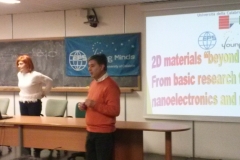 The Calabria YM Section realized a cycle of seminars addressed to undergraduate students:
The Calabria YM Section realized a cycle of seminars addressed to undergraduate students:
- Two-dimensional materials from graphene to “beyond graphene” and their plasmonic modes (Prof. Anna Cupolillo with an introduction by prof. Gennaro Chiarello);
- When plasmonics meet Terahertz technology (Dr. Antonio Politano).
The emergence of two-dimensional materials has been discussed. In particular, prof. Cupolillo introduced the groundbreaking impact of graphene on condensed-matter physics and the pitfalls of graphene-based devices. The necessity of going beyond graphene has been clarified. The attention was focused on phosphorene, also in consideration of the recent success of experiments carried out on our department on this material. After a detailed introduction on the two-dimensional atlas of advanced materials, plasmons have been introduced with their peculiarities in these materials.
In the seminar on Terahertz technology, the state of the art has been presented, with attention on the various aspects: the characteristics of the Terahertz radiation, the use of plasma waves to detect Terahertz radiation and the application in technology. It has been clarified that THz radiation has no endangering effects on human beings and enables higher contrast for “soft matter” than x-rays. The excitations of plasmons inside the active channel of nano-transistors devised for Terahertz detection has been introduced. The plasma-wave detection mechanism is just the most promising mechanism for introducing Terahertz technology in daily life.
Plasma-wave-based THz detectors open new possibilities of construction of real-time THz imaging systems. Most plastics, textiles and paper are nearly transparent for THz radiation. Therefore, further application fields are industrial quality inspection control, customs inspection and security screening of persons. Imaging experiments taken on 10 ms have been presented, to demonstrate the feasibility to use Terahertz photodetectors as body scanner, instead of the X-rays, which are ionizing radiation, which can be harmful for human health.
In general, particular attention has been dedicated to the attempt to improve the interaction with other departments. This is beneficial for our EPS-YM section, since we find a lot of interest toward two-dimensional materials from mechanical engineers in our university. We find different contact points with young researchers in nanomechanics.
Seminars have been attended by about 35 students, coming from Physics, Materials Science and Mechanical Engineering.
After the seminars, a discussion with students about the prospect of applied research on advanced materials has been done, under the coordination of prof. Chiarello, associate professor of Applied Physics.
[nggallery id=40]
